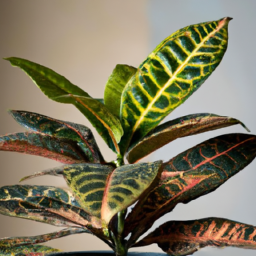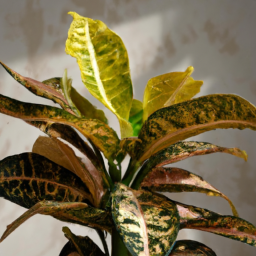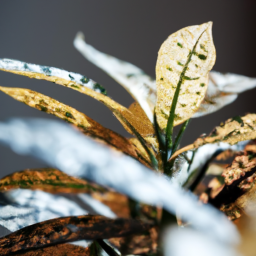
If you’re looking to add some vibrant and colorful foliage to your indoor space, crotons are a fantastic choice. Crotons are tropical plants known for their striking, multicolored leaves that can instantly brighten up any room. In this blog post, we’ll discuss everything you need to know about Croton care indoor, from lighting and watering requirements to tips for keeping your plant healthy and thriving. Whether you’re a seasoned plant parent or a beginner looking to add some greenery to your home, crotons are a beautiful and low-maintenance option that will add a pop of color to your indoor space.
Choosing the Right Location for Indoor Croton Plants
When it comes to caring for indoor Croton plants, one of the most important factors to consider is the location where you place them. Croton plants require specific conditions to thrive, so it’s essential to choose the right spot in your home. In this guide, we will discuss the key factors to consider when selecting a location for your indoor Croton plants.
Lighting Requirements
One of the most critical factors in caring for indoor Croton plants is providing them with the right amount of light. Croton plants thrive in bright, indirect light, so it’s essential to place them in a location where they can receive plenty of natural light. Avoid placing your Croton plant in direct sunlight, as this can cause the leaves to burn. If you notice that your Croton plant is not getting enough light, consider moving it to a brighter location or supplementing with a grow light.
In addition to the amount of light, it’s also crucial to consider the quality of light that your Croton plant is receiving. Fluorescent lights can be a good option for providing supplemental light to your Croton plant, but be sure to place the light source at the correct distance from the plant to avoid burning the leaves. Overall, providing the right amount and quality of light is essential for the health and growth of your indoor Croton plant.
Another important factor to consider when choosing a location for your indoor Croton plant is the temperature of the room. Croton plants thrive in temperatures between 60-85 degrees Fahrenheit, so it’s essential to avoid placing them in areas that are too hot or too cold. Avoid placing your Croton plant near drafty windows or doors, as this can cause temperature fluctuations that can stress the plant. Additionally, be sure to keep your Croton plant away from heating or cooling vents that can create extreme temperature changes.
Humidity Levels
Croton plants thrive in humid environments, so it’s essential to consider the humidity levels in your home when choosing a location for your indoor Croton plant. If you live in a dry climate or have low humidity levels in your home, consider using a humidifier to increase the moisture in the air around your Croton plant. You can also place a tray of water near your plant to help increase humidity levels. Be sure to monitor the humidity levels regularly and adjust as needed to ensure that your Croton plant is thriving.
In addition to humidity levels, it’s also essential to consider air circulation when choosing a location for your indoor Croton plant. Good air circulation is crucial for preventing pests and diseases from affecting your plant. Avoid placing your Croton plant in areas with poor air circulation, such as corners or behind furniture. Consider using a fan to help improve air circulation around your plant and prevent issues with pests and diseases.
Overall, choosing the right location for your indoor Croton plant is essential for its health and growth. By considering factors such as lighting, temperature, humidity levels, and air circulation, you can create the ideal environment for your Croton plant to thrive. Be sure to monitor your plant regularly and make adjustments as needed to ensure that it remains healthy and vibrant.

Essential Tips for Watering Indoor Croton Plants
Understanding Croton Watering Needs
When it comes to caring for indoor Croton plants, one of the most important aspects to consider is watering. Crotons are tropical plants that require consistent moisture to thrive, but overwatering can lead to root rot and other issues. It’s essential to strike the right balance when it comes to watering your Croton plants.
One key factor to keep in mind is that Crotons prefer to dry out slightly between waterings. This means that you should allow the top inch of soil to dry out before watering again. Overwatering can lead to root rot, so it’s crucial not to keep the soil too wet for too long. On the other hand, underwatering can cause the leaves to wilt and drop off, so it’s important to monitor your plant’s moisture levels regularly.
Another important consideration is the type of water you use to water your Croton plants. Tap water can contain chemicals such as chlorine and fluoride, which can be harmful to your plants over time. To avoid this, consider using filtered or distilled water for your Crotons. Additionally, make sure to water your plants with room temperature water, as cold water can shock the roots and cause stress to the plant.
Best Practices for Watering Indoor Croton Plants
To ensure that your indoor Croton plants are getting the right amount of water, it’s important to establish a consistent watering schedule. Aim to water your Crotons when the top inch of soil is dry to the touch, but be mindful not to let the soil completely dry out. This may require watering your plants every 1-2 weeks, depending on the humidity levels in your home.
When watering your Croton plants, make sure to water the soil directly at the base of the plant. Avoid getting water on the leaves, as this can lead to fungal issues and other problems. Additionally, make sure that your pots have proper drainage holes to allow excess water to escape. Standing water at the bottom of the pot can lead to root rot, so it’s crucial to ensure that your plants are not sitting in water.
In addition to regular watering, it’s important to monitor the humidity levels around your Croton plants. Crotons thrive in high humidity environments, so consider using a humidifier or placing a tray of water near your plants to increase moisture levels. Misting your plants with water can also help to boost humidity, but be careful not to overdo it, as this can lead to fungal issues.
Troubleshooting Common Watering Issues
Despite your best efforts, you may encounter some common watering issues with your indoor Croton plants. If you notice that the leaves are turning yellow and dropping off, this could be a sign of overwatering. In this case, allow the soil to dry out completely before watering again, and consider repotting your plant in fresh, well-draining soil.
On the other hand, if you notice that the leaves are wilting and drooping, this could be a sign of underwatering. In this case, water your plant thoroughly and consider increasing the frequency of your watering schedule. It’s important to strike the right balance when it comes to watering your Croton plants, so pay close attention to your plant’s moisture levels and adjust your watering routine as needed.
By following these essential tips for watering indoor Croton plants, you can help your plants thrive and flourish in your home. Remember to monitor your plant’s moisture levels regularly, establish a consistent watering schedule, and provide the right environmental conditions for your Crotons to thrive. With proper care and attention, your indoor Croton plants can be a beautiful and vibrant addition to your indoor space.

Common Pests and Diseases to Watch Out for When Caring for Indoor Crotons
Pests
When caring for indoor Crotons, it’s important to be aware of common pests that can wreak havoc on your plants. One of the most common pests that affect Crotons is spider mites. These tiny pests are difficult to see with the naked eye, but you may notice fine webbing on the leaves of your plant. Spider mites feed on the sap of the plant, which can cause the leaves to become discolored and eventually drop off. To get rid of spider mites, you can try spraying your plant with a mixture of water and mild dish soap.
Another common pest that can affect indoor Crotons is mealybugs. Mealybugs are small, white insects that feed on the sap of the plant. They can often be found in the crevices of the plant, such as where the leaves meet the stem. To get rid of mealybugs, you can try wiping them off with a cotton swab dipped in rubbing alcohol. You may need to repeat this process several times to completely eliminate the infestation.
Aphids are another common pest that can affect indoor Crotons. These small insects feed on the sap of the plant and can cause the leaves to become distorted and yellow. To get rid of aphids, you can try spraying your plant with a mixture of water and neem oil. Neem oil is a natural insecticide that can help to repel aphids and other common pests.
Diseases
In addition to pests, indoor Crotons can also be susceptible to diseases. One common disease that affects Crotons is root rot. Root rot is caused by overwatering the plant, which can lead to the roots becoming waterlogged and eventually rotting. To prevent root rot, it’s important to ensure that your Croton is planted in well-draining soil and that you allow the top inch of soil to dry out between waterings.
Another common disease that can affect indoor Crotons is powdery mildew. Powdery mildew is a fungal disease that appears as a white, powdery substance on the leaves of the plant. To prevent powdery mildew, it’s important to ensure that your plant has good air circulation and that you avoid overhead watering. If your plant does develop powdery mildew, you can try spraying it with a mixture of water and baking soda to help control the spread of the disease.
Leaf spot is another common disease that can affect indoor Crotons. Leaf spot appears as dark, water-soaked spots on the leaves of the plant and is caused by a fungal or bacterial infection. To prevent leaf spot, it’s important to ensure that your plant is not overcrowded and that you avoid getting the leaves wet when watering. If your plant does develop leaf spot, you can try trimming off the affected leaves and applying a fungicide to help control the spread of the disease.
Conclusion
In conclusion, when caring for indoor Crotons, it’s important to be aware of common pests and diseases that can affect your plants. By taking proactive measures to prevent and control infestations, you can help to ensure that your Crotons remain healthy and vibrant. Remember to regularly inspect your plants for signs of pests and diseases, and take action promptly if you notice any issues. With proper care and attention, your indoor Crotons can thrive and bring beauty to your home for years to come.
Here’s the Summary Snapshot
If you’re looking to add some greenery to your indoor space, croton plants are a great choice. These vibrant, colorful plants are known for their striking foliage and can add a pop of color to any room. However, caring for croton plants indoors does require some specific attention to ensure they thrive.
Croton plants need plenty of bright, indirect light to grow successfully indoors. Make sure to place them near a window where they can receive ample sunlight throughout the day. Additionally, croton plants prefer humid environments, so misting them regularly or placing a humidifier nearby can help keep them happy and healthy. Watering is also important for croton plants, but be careful not to overwater as they are prone to root rot. Allow the top inch of soil to dry out before watering again, and make sure the pot has good drainage to prevent waterlogged soil. With the right care and attention, your croton plant can become a beautiful and vibrant addition to your indoor space.
FAQ Compilation:
Q1. How often should I water my indoor Croton plant?
A1. It is important to keep the soil of your indoor Croton plant consistently moist but not waterlogged. Water your Croton plant when the top inch of soil feels dry to the touch, typically every 1-2 weeks depending on the humidity levels in your home.
Q2. What kind of light does an indoor Croton plant need?
A2. Indoor Croton plants thrive in bright, indirect light. Place your Croton plant near a window where it can receive plenty of sunlight, but be sure to avoid direct sunlight as it can scorch the leaves.
Q3. How can I prevent my indoor Croton plant from dropping leaves?
A3. Dropping leaves on an indoor Croton plant can be a sign of stress. To prevent this, make sure your Croton plant is not exposed to drafts or sudden temperature changes. Keep the humidity levels stable and avoid overwatering or underwatering.
Q4. Can I fertilize my indoor Croton plant?
A4. Yes, you can fertilize your indoor Croton plant during the growing season (spring and summer) with a balanced liquid fertilizer diluted to half strength. Fertilize every 4-6 weeks to promote healthy growth and vibrant foliage.
Q5. How do I prune my indoor Croton plant?
A5. Pruning your indoor Croton plant is important to maintain its shape and encourage new growth. Use clean, sharp scissors to trim back any leggy or overgrown branches. You can also remove any dead or yellowing leaves to keep your Croton plant looking its best.

James Wong is a renowned ethnobotanist, plant scientist, and local television presenter. With a passion for demystifying plant science, he is known for translating complex botanical concepts into practical advice for everyday plant enthusiasts. James’s expertise spans from traditional gardening to cutting-edge plant technologies, making his insights accessible and informative.


